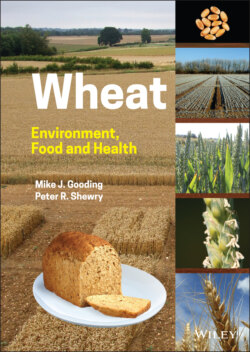Читать книгу Wheat - Peter R. Shewry - Страница 18
1.2.1.2 Leaves
ОглавлениеThe stem apex usually remains just below ground level during the further vegetative phases, where it is partially protected from herbivory and extremes of temperature. The apex itself may only be 0.1 mm in length (Figure 1.7) and produces primordia, from which leaves expand and are pushed upwards. The leaf production growth stages (DGS = 1n) start with the emergence of the first leaf through the coleoptile (Figure 1.9). A leaf is counted as being fully emerged or unfolded based on the emergence of the collar, which is the junction between the leaf lamina (or blade) and the leaf sheath. The leaf sheaths are usually hairy (non‐glabrous). The leaf laminas are narrow with about 12 veins. Small additional structures on the collar become visible, particularly on the larger leaves; these are the auricles and the ligule (Figure 1.9). The auricles are useful for distinguishing wheat from other cereals before the ears emerge. Whereas the wheat auricles are commonly 1–3 mm long and are usually covered in hairs, barley auricles are hairless, oats have no auricles, and rye auricles are much shorter. The ligule is blunt and between 2 and 4 mm long. The sheath and lamina are contiguous. The sheath connects the leaf to its node on the true stem. While the plant is in the vegetative stage, the nodes remain compressed on a short stem (< 5 mm) behind the stem apex at the base of the plant. New leaves become externally visible as they emerge from within the leaf sheath of the previous leaf. The DGS progresses as each leaf becomes fully unfolded (Figure 1.9).
Figure 1.9 The leaf production phase of wheat. Boxed numerals are the decimal growth stage scores from Table 1.4.
